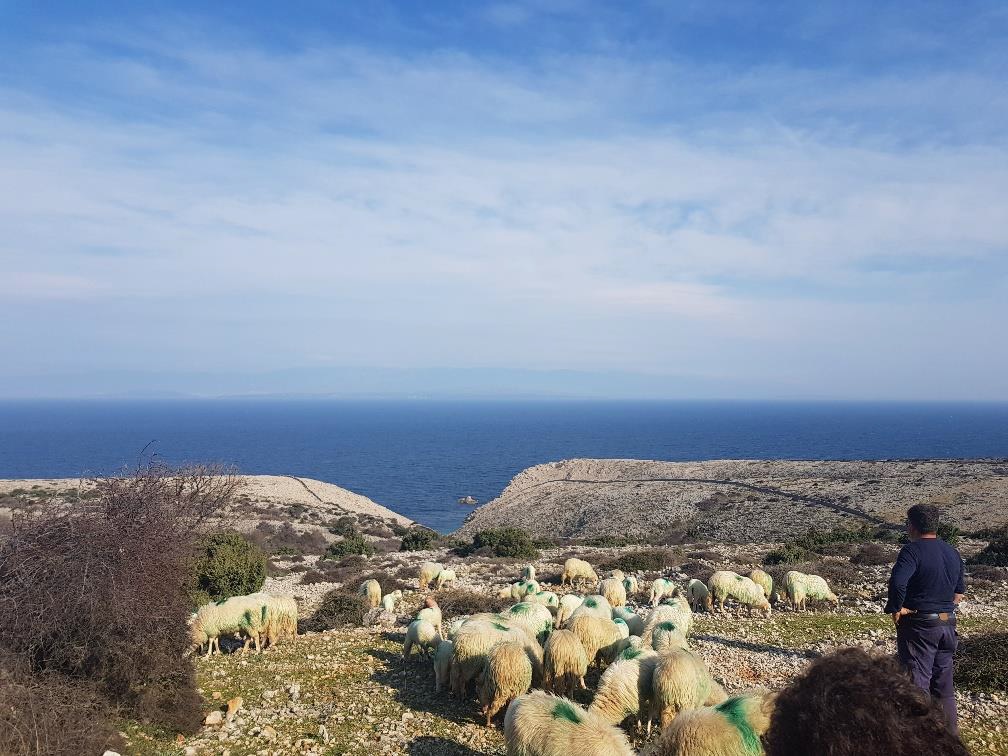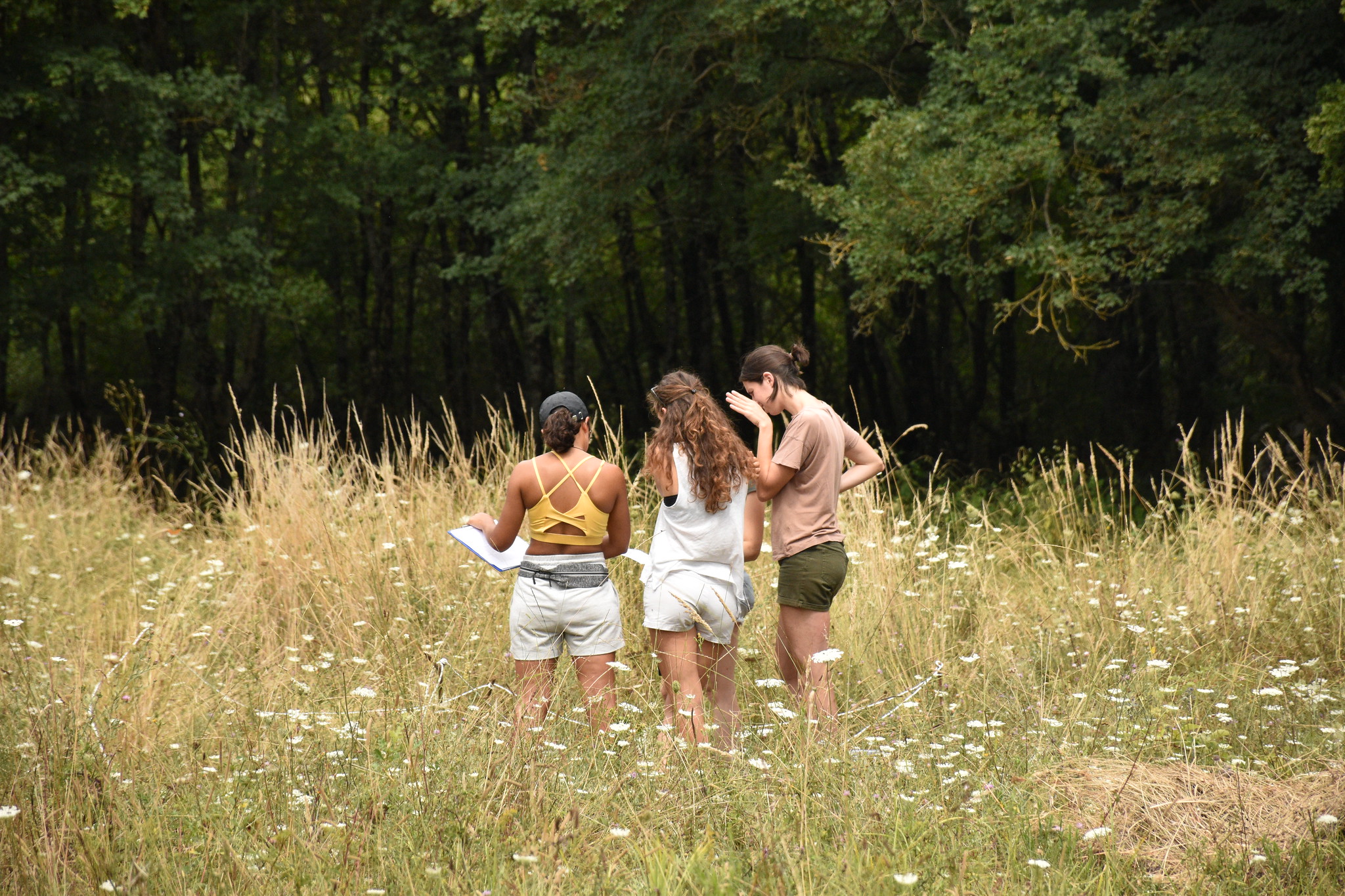Out of seven spots visited, in three we found dead birds – not a small number
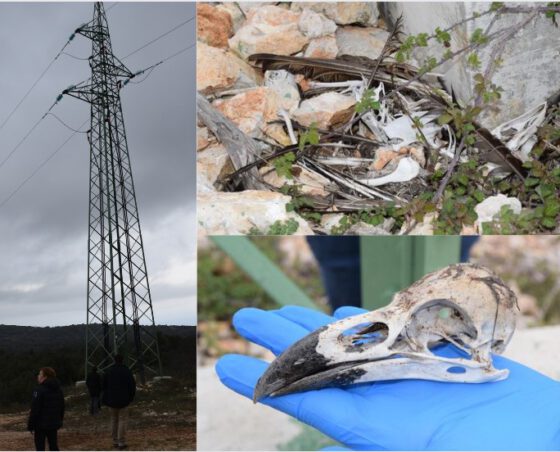
In March, we held a volunteer educational workshop on electrocution monitoring on Cres as part of the LIFE SUPport project. Despite various protection measures installed on electricity poles by HEP-ODS d. o. o. together with Biom, bird fatalities caused by electrocution are still happening and require further measures and regular monitoring. Electrocution is one of the most significant causes of death for griffon vultures on Cres. In addition, most common victims of electrocution are common ravens (
Corvus corax), gulls (
Laridae), kestrels (
Falco tinnunculus), and buzzards (
Buteo buteo), mostly birds with large wingspan, which we confirmed during this monitoring session.
The first day began with a lecture on the issues caused by electrocution as well as the technical side, which is important to understand. In order to be competent for carrying out the monitoring first it is necessary to learn how to distinguish different types of electrical poles as well as the ‘head’ of the pole i.e. how can the conductors be placed. There are several conductor configurations, most common ones are gamma (a), delta (b), and fir (c).
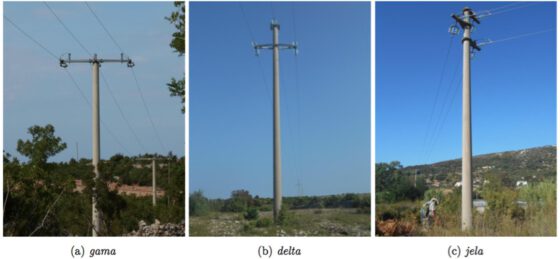
Delta and gamma poles types are the most dangerous because the distance between conductors is small so the birds that land on the power line close the electrical circuit as their wings bridge two live conductors (1) or touch a live conductor and the ground (2).
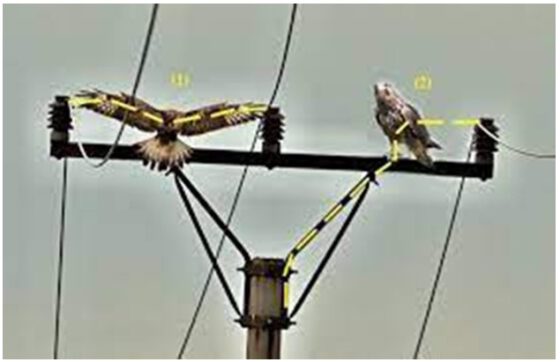
After going through the theory basics, we were ready to go into the field. After sleeping in the centre for griffon vultures and visiting their rehabilitation centre, we also had a chance to see them up close. To see such a large and special bird leaves quite an impression, and knowing Cres is one of the last places in Croatia where they nest, our desire to learn and take part in their conservation only became greater. The fieldwork was comprised of 7 different points within which are critical electrical poles, as well as those poles that are examples of good practices, where barriers were placed to prevent birds landing, or have perches installed instead.
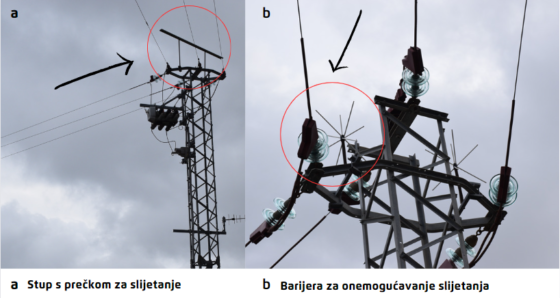
Visiting the first point we saw the difference between gamma and delta poles, and when we reached the second point, unfortunately, we saw what an electrocuted bird looks like.
Directly underneath the gamma-shaped pole, we found a dead raven. It is necessary to collect the dead bird and move it away from the pole so that it is not counted repeatedly during the next monitoring. Unfortunately, in addition to this raven, we found another two dead birds during this monitoring session, another raven and a gull.
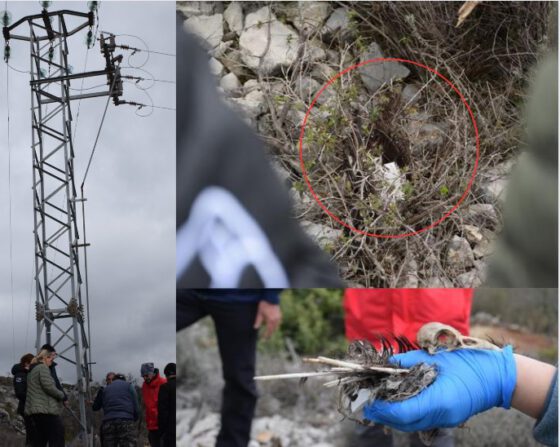
The gull was found in a bush next to an Electrical substation, and the raven under a fir-shaped pole.
Conductors in fir configuration are considered safer than gamma and delta, however, this is an example that while they may be safer, they also cause bird fatalities.
Out of seven spots visited, in three we found killed birds – not a small number. Two days of education on Cres proved to be useful. In the field, we were able to see examples of everything we learnt the day before, which provided better insight and understanding of the topic, and also gave good guidelines for independent monitoring. By independent monitoring we mean monitoring in pairs, as this activity must never be done alone!
What we can confirm is that when you begin monitoring alongside your partner and expert guidance is not around, be certain you are not alone. Griffon vultures are constantly above you, watching and gliding on thermal air, just as they did during our field day.
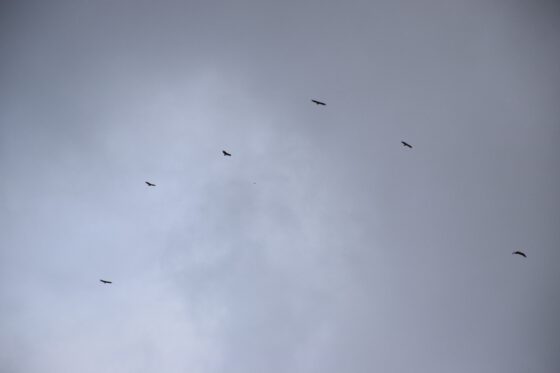 Author: Ivana Lokas
Author: Ivana Lokas In March, we held a volunteer educational workshop on electrocution monitoring on Cres as part of the LIFE SUPport project. Despite various protection measures installed on electricity poles by HEP-ODS d. o. o. together with Biom, bird fatalities caused by electrocution are still happening and require further measures and regular monitoring. Electrocution is one of the most significant causes of death for griffon vultures on Cres. In addition, most common victims of electrocution are common ravens (Corvus corax), gulls (Laridae), kestrels (Falco tinnunculus), and buzzards (Buteo buteo), mostly birds with large wingspan, which we confirmed during this monitoring session.
The first day began with a lecture on the issues caused by electrocution as well as the technical side, which is important to understand. In order to be competent for carrying out the monitoring first it is necessary to learn how to distinguish different types of electrical poles as well as the ‘head’ of the pole i.e. how can the conductors be placed. There are several conductor configurations, most common ones are gamma (a), delta (b), and fir (c).
In March, we held a volunteer educational workshop on electrocution monitoring on Cres as part of the LIFE SUPport project. Despite various protection measures installed on electricity poles by HEP-ODS d. o. o. together with Biom, bird fatalities caused by electrocution are still happening and require further measures and regular monitoring. Electrocution is one of the most significant causes of death for griffon vultures on Cres. In addition, most common victims of electrocution are common ravens (Corvus corax), gulls (Laridae), kestrels (Falco tinnunculus), and buzzards (Buteo buteo), mostly birds with large wingspan, which we confirmed during this monitoring session.
The first day began with a lecture on the issues caused by electrocution as well as the technical side, which is important to understand. In order to be competent for carrying out the monitoring first it is necessary to learn how to distinguish different types of electrical poles as well as the ‘head’ of the pole i.e. how can the conductors be placed. There are several conductor configurations, most common ones are gamma (a), delta (b), and fir (c).
 Delta and gamma poles types are the most dangerous because the distance between conductors is small so the birds that land on the power line close the electrical circuit as their wings bridge two live conductors (1) or touch a live conductor and the ground (2).
Delta and gamma poles types are the most dangerous because the distance between conductors is small so the birds that land on the power line close the electrical circuit as their wings bridge two live conductors (1) or touch a live conductor and the ground (2).
 After going through the theory basics, we were ready to go into the field. After sleeping in the centre for griffon vultures and visiting their rehabilitation centre, we also had a chance to see them up close. To see such a large and special bird leaves quite an impression, and knowing Cres is one of the last places in Croatia where they nest, our desire to learn and take part in their conservation only became greater. The fieldwork was comprised of 7 different points within which are critical electrical poles, as well as those poles that are examples of good practices, where barriers were placed to prevent birds landing, or have perches installed instead.
After going through the theory basics, we were ready to go into the field. After sleeping in the centre for griffon vultures and visiting their rehabilitation centre, we also had a chance to see them up close. To see such a large and special bird leaves quite an impression, and knowing Cres is one of the last places in Croatia where they nest, our desire to learn and take part in their conservation only became greater. The fieldwork was comprised of 7 different points within which are critical electrical poles, as well as those poles that are examples of good practices, where barriers were placed to prevent birds landing, or have perches installed instead.
 Visiting the first point we saw the difference between gamma and delta poles, and when we reached the second point, unfortunately, we saw what an electrocuted bird looks like.
Directly underneath the gamma-shaped pole, we found a dead raven. It is necessary to collect the dead bird and move it away from the pole so that it is not counted repeatedly during the next monitoring. Unfortunately, in addition to this raven, we found another two dead birds during this monitoring session, another raven and a gull.
Visiting the first point we saw the difference between gamma and delta poles, and when we reached the second point, unfortunately, we saw what an electrocuted bird looks like.
Directly underneath the gamma-shaped pole, we found a dead raven. It is necessary to collect the dead bird and move it away from the pole so that it is not counted repeatedly during the next monitoring. Unfortunately, in addition to this raven, we found another two dead birds during this monitoring session, another raven and a gull.
 The gull was found in a bush next to an Electrical substation, and the raven under a fir-shaped pole.
Conductors in fir configuration are considered safer than gamma and delta, however, this is an example that while they may be safer, they also cause bird fatalities.
Out of seven spots visited, in three we found killed birds – not a small number. Two days of education on Cres proved to be useful. In the field, we were able to see examples of everything we learnt the day before, which provided better insight and understanding of the topic, and also gave good guidelines for independent monitoring. By independent monitoring we mean monitoring in pairs, as this activity must never be done alone!
What we can confirm is that when you begin monitoring alongside your partner and expert guidance is not around, be certain you are not alone. Griffon vultures are constantly above you, watching and gliding on thermal air, just as they did during our field day.
The gull was found in a bush next to an Electrical substation, and the raven under a fir-shaped pole.
Conductors in fir configuration are considered safer than gamma and delta, however, this is an example that while they may be safer, they also cause bird fatalities.
Out of seven spots visited, in three we found killed birds – not a small number. Two days of education on Cres proved to be useful. In the field, we were able to see examples of everything we learnt the day before, which provided better insight and understanding of the topic, and also gave good guidelines for independent monitoring. By independent monitoring we mean monitoring in pairs, as this activity must never be done alone!
What we can confirm is that when you begin monitoring alongside your partner and expert guidance is not around, be certain you are not alone. Griffon vultures are constantly above you, watching and gliding on thermal air, just as they did during our field day.
 Author: Ivana Lokas
Author: Ivana Lokas



